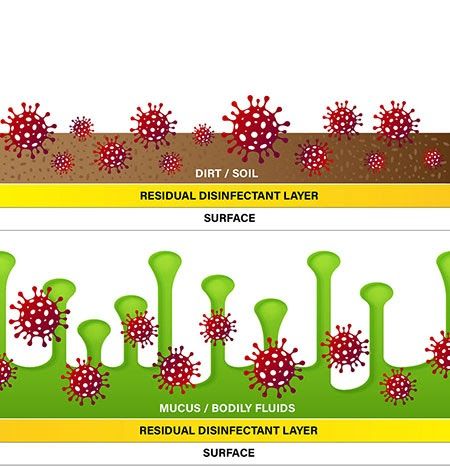Choosing The Right Disinfectant
If you are seeking an effective disinfectant for your facility, there are core issues to consider. Your disinfectant should quickly and virtually completely obliterate bacteria, viruses, and fungi, while not eroding or dis-colouring surfaces and appliances - and operator and end user safety is critical to consider. Disinfection is a higher standard of hygiene than sanitising (read our blog) - only one in a million bacteria may be left in a disinfection process compared with one in a thousand for sanitising. Some environments may insist certain disinfectant types are used or not used depending on risks to users or facilities for e.g. preschools and aged care have vulnerable people to consider compared with industrial workshops or mining environments.
What To Consider
There are three key criteria to consider - viability of cleaning and disinfection, kill time, and safety.
Viability
The primary concern that should focus on is whether or not the disinfectant solution you pick can deal with the threat, and the cleaning process is understood. Surfaces need to be cleaned of debris - or that debris acts as a barrier between the disinfectant and the surface. Some disinfectants contain surfactants to release dirt and assist the cleaning process. Disinfectant types have varied capabilities and suitability - bases with alcohol or quats or hydrogen peroxide or chlorine need careful choice. Chemicals that claim to have residual bacteria killing capability will not work if a dirt barrier builds up on the chemical as a barrier between it and the fresh bacteria. So a cleaner releasing dirt from a surface needs to ensure the cloth, or pad, or vacuum removes all the dirt leaving a surface clean and ready for a disinfectant to do its job.
It’s necessary to kill the pathogens and microbes that are the primary concern of your facility. COVID is a highly topical concern needing TGA approved COVID killers. A few products, such as Viraclean, Biosan, Counterflu, are TGA-approved as powerful against this kind of bacteria.
Cleaners need to know the correct cleaning process and tools to safely clean and disinfect. There is routine cleaning, and then it may be necessary to do an urgent deep clean if there is known infection to eradicate. Look through our wide range to find the product that suits your needs.
Cleaning tools make a big difference to cleaning effectiveness when disinfecting. String mops leave the most dirt and waste water behind as they gather and extract dirt poorly, especially as the bucket water gets dirtier. Flat mops are better as they gather dirt and are changed regulalry as the pad dirt load builds. Mechanised scrubbers dispense disinfectant, scrubb surfaces, and extract the waste water, leaving surfaces the most clean.
Kill Time
Depending upon your industry, there are kill time considerations for different threats and chemicals that are selected. The formulas behind these products are designed to kill specific microbes in a particular amount of time. Some chemicals need 5-10 minutes, meaning enough liquid needs to be applied not to evaporate before the process is complete, others require less than a minute. The dilution instructions must be followed or the disinfectant will not be strong enough. Some COVID killing chemicals are used neat, some can be diluted 16:1. Hospitality commonly uses a rinse free sanitiser sprayed onto tables and counters after cleaning, that is food safe when left to dry.
Safety
Some chemical products are hazardous to touch or inhale requiring PPE (Personal Protective Equipment), some may stain or leach colour, and others are destructive to certain surfaces - all need to be matched to a specific need or environment. Look out for flammability and toxicity ratings on all chemical items indicated by GHS Dangerous Goods labelling all manufacturers have to declare. Get staff to complete a free chemical awareness and handling course offered by Rapid Clean. Understand PH ratings from highly acidic PH1 to highly alkaline PH14 - extremes are both just as dangerous even though people often just think acids are a problem.
In summary, disinfectants can achieve specific safety and hygiene standards to make environments safe to work or play or recover in. Operators and end users need protection during the disinfection process. Selecting the right tools and equipment enhances safety and effectiveness.
Please browse our range or contact us directly!
Rapid Clean Newcastle Pty - www.rapidcleannewcastle.com.au - tel 02 4908 2333



